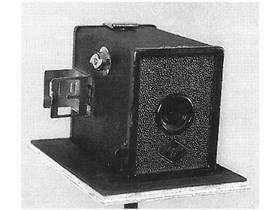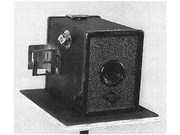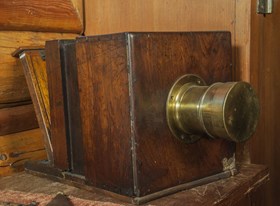Narrow Results By
- Date
- c. 1910
- Material
- leather; metal; glass; wood; plastic; textile
- Catalogue Number
- 104.41.0249
- Description
- Buster Brown box camera with brown leather handle. Solid structure with black textile covering made to resemble leather. The front of the camera has a hole that likely once held a lens. There are two smaller holes in the upper corner of the front, which contain small glass parts. There is also meta…
1 image
- Title
- Box Camera
- Date
- c. 1910
- Material
- leather; metal; glass; wood; plastic; textile
- Dimensions
- 13.5 x 9.7 x 15.9 cm
- Description
- Buster Brown box camera with brown leather handle. Solid structure with black textile covering made to resemble leather. The front of the camera has a hole that likely once held a lens. There are two smaller holes in the upper corner of the front, which contain small glass parts. There is also metal hardware holding the front exterior panel to the structure. One side has a round hole with glass held by metal hardware, creating a viewfinder. There is also a metal winding mechanism, and a lever for the shutter release. The lever activates a mechanism that quickly uncovers and then re-covers the inner lens. The rear part of the camera has a small round, red-tinted window that would have shown the number for the section of film in position. At the top is a metal hinge that can be lifted to open the back panel, which comes down and is connected with a textile hinge. The top of the camera has a leather handle attached with metal pegs. The leather handle is worn, but you can see that it has been engraved by the manufacturer with the text: “No. 2A BUSTER BROWN”. There is also a viewfinder on the front corner. When the metal latch is opened, the rear panel opens and the interior cartridge can be seen. Pulling out the handle of the winding mechanism on the side of the camera releases the cartridge so that it can be removed. It’s a wooden box with a lens on the front and it has compartments for spools that hold the film. There is a spool in one side, but the other is empty. There are also two metal rollers that would hold the film in place. One side of the wooden cartridge is engraved with the following text: “MFD. BY”; “ANSCO COMPANY”; “BINGHAMTON, N.Y.”; “U.S.A.”; “PATENTED”; “JUNE 23 1903”; “SEPT. 20 1910”; “OTHER PAT. PENDING”; “FOR 6A OR 6B FILM”. Above the engraving is some handwriting in pencil that reads “6-A”; “2 1/2 x 4 1/2”. link to pdf of user manual: http://www.cameramanuals.org/agfa_ansco/ansco_buster_brown_camera.pdf
- Credit
- Gift of Don Harmon, Banff, 1985
- Catalogue Number
- 104.41.0249
Images
This material is presented as originally created; it may contain outdated cultural descriptions and
potentially offensive content.
Read more.
- Date
- 1938
- Material
- metal; glass; paper
- Catalogue Number
- 104.41.1113 a,b
- Description
- A simple black box camera with black, simulated textured leather. It also has an adhesive-taped, original box. The inverted aperture in the front has a black metal retention ring surrounding it. Below this “Agfa” is imprinted on the camera, surrounded by a diamond-shaped box. There is a black metal…
1 image
- Title
- Box Camera
- Date
- 1938
- Material
- metal; glass; paper
- Dimensions
- 8.5 x 6.5 cm
- Description
- A simple black box camera with black, simulated textured leather. It also has an adhesive-taped, original box. The inverted aperture in the front has a black metal retention ring surrounding it. Below this “Agfa” is imprinted on the camera, surrounded by a diamond-shaped box. There is a black metal rim which overlaps the edges on the front of the camera; on both sides there is a slight extension, .03 x.05 wide, 2.0cm from the top, with a hole in the metal. This fits over two small metal knobs on each side of the camera body. It appears that pushing the knobs in and pulling, would release the front part of the camera from the body. On the viewer’s left is the metal shutter release; a small metal lever that can be pulled down to release the shutter and expose the lens from inside the body. On the same side is the metal film winder, 3.0cm from the front and .50cm from the top; this is a flat piece of metal 2.0cm in diameter, with arrows indicating the direction to turn (clockwise arrows), a round raised metal tab, onto which is screwed a piece of metal (2.5cmx1.0cm wide in the middle) to wind the film. It can also be pulled out to release the metal film chamber. The metal is turned down on the side of each end so the fingers can grasp it for turning. A metal folding viewfinder is .50cm from the back and 2.7cm from top and bottom; a flat piece of metal 3.0cm sq., folded at the sides, is rivetted onto the body. Two flat metal pieces are attached at each end, one on a spring to fold down; this piece is 2.4x2.7cm wide with a window cut out .50x1.0cm wide. The other piece is 2.7cm sq. with a window of 1.5x2.4cm wide; the cutout has a piece of metal raised from the bottom of the window. The cutout is for perspective when you look through the viewfinder, vertically or horizontally. This piece of metal folds down to become the top, effectively making the viewfinder flat when not in use. There is a hinged door on the back of the camera and a cut-out metal latch on the door that connects to a small metal knob 1.0cm from the edge of the body. There is a red circle film window (1.0cm diagonally) which lets you read the frame number on the film. On the inside of the door are two rivets that connect the hinge. Above that and below the red circle, is a white painted circle with “USE AB” printed in black, overlapping a painted orange, blue, white, and yellow Agfa Plenachrome film box. The red viewfinder is 4.0cm from the base. A metal film chamber, with two metal rollers on each end for winding the film on, fits inside the camera. It can be released by pulling out the film winder. The canister is 7.0x5.0 wide, is open at one end, hollow in the centre, sloping upwards with a circular hole at the other end to let light in. There are two sprockets sitting on two cutouts on top of the canister and two on the bottom, onto which the film is winded. There are two rivets attaching two Y-shaped metal pieces, on either end that guide and let the film move and roll. The top of the camera has two metal knobs 1.5cm crosswise from each end, where a leather strap with a hole on either end, .07cm from the edge, fits in to make a diagonal strap/handle for carrying. The strap is imprinted with “A-8 CADET”. There is a small metal pull-up tab, 1.0cm from the edge of the front of the camera, that lets you time the shutter speed.
- Subject
- households
- photography
- hobbies
- Bob Louden
- Credit
- Gift of Bob Louden, Calgary, 2004
- Catalogue Number
- 104.41.1113 a,b
Images
This material is presented as originally created; it may contain outdated cultural descriptions and
potentially offensive content.
Read more.
- Date
- 1840 – 1850
- Material
- wood; glass; metal
- Catalogue Number
- 104.41.0005 a,b
- Description
- (a) Large dark brown wooden box camera which is constructed so that back half of camera slides into front half to focus and is secured in place by means of a brass thumbscrew into a slot in the base. Large brass lens screwed over aperture hole at centre of front side of wooden box, square glass pla…
1 image
- Title
- Box Camera
- Date
- 1840 – 1850
- Material
- wood; glass; metal
- Dimensions
- 25.2 x 24.0 x 42.3 cm
- Description
- (a) Large dark brown wooden box camera which is constructed so that back half of camera slides into front half to focus and is secured in place by means of a brass thumbscrew into a slot in the base. Large brass lens screwed over aperture hole at centre of front side of wooden box, square glass plate set into wooden frame slides into slot at back of camera. (b) a separate plateholder of the same size has hinged door on back of frame which opens to insert black metal film sheath (Eastman Kodak), and front of frame slides out by pulling on metal ring at top to expose film. Note: wood cracking and separated at joints, chipped at lower front corners with large chunk of wood out of lower right, plateholder cracked across door and on one side of top.
- Subject
- households
- hobbies
- photography
- J.D. Curren
- PW
- Credit
- Gift of Catharine Robb Whyte, O. C., Banff, 1979
- Catalogue Number
- 104.41.0005 a,b
Images
This material is presented as originally created; it may contain outdated cultural descriptions and
potentially offensive content.
Read more.






